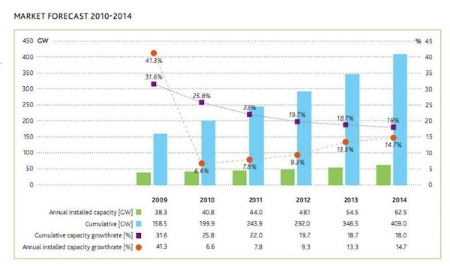Global Wind 155 GW in 2009 – 409 GW Forecast for 2014
Global wind energy markets are expected to continue their rapid growth, with the world’s wind power capacity increasing by 160% over the coming five years, according to the annual industry forecast presented by the Global Wind Energy Council (GWEC).
The two markets leading global wind power expansion will continue to be the U.S. and China, whose markets have exceeded all expectations in recent years.
GWEC said that it expects that the global installed wind capacity will reach 409 GW by 2014, up from 158.5 GW at the end of 2009. This assumes an average growth rate of 21% per year, which is conservative compared to the 29% average growth that the wind industry experienced over the past decade. The organization predicts that in 2014, total wind capacity additions will be more than 60 GW, up from the 38.3 GW of annual wind capacity installations in 2009.
GWEC will present its full annual Global Wind 2009 Report at the European Wind Energy Conference in Warsaw on April 21 2010, which will include a five year forecast for the development of the global wind energy market. In the past, these projections have regularly been outstripped by the actual performance of the industry and have had to be adjusted upwards. Despite the ramifications of the financial crisis, 2009 was no exception.
The two markets leading global wind power expansion will continue to be the U.S. and China, whose markets have exceeded all expectations in recent years.
North America Wind
While in the U.S., the development for 2010 will be hampered by continued tightness in the financial markets and the overall economic downturn, the provisions of the US government’s Recovery Act, and in particular the grant programs, will continue to counteract the impacts of the crisis.
Coupled with legislative uncertainty at the federal level in Canada, the result is that the North American market is forecast to stay flat for the next couple of years, and then pick up again in 2012, to reach a cumulative total of 101.5 GW by 2014 (up from 38.5 GW in 2009). This would translate into an addition of 63 GW in the US and Canada over the next five years.
Chinese Wind Growth
In China, growth is set to continue at a breathtaking pace. Already in 2009, China accounted for one third of total annual wind capacity additions, with 13.8 GW worth of new wind farms installed. This took China’s total capacity up to 25.9 GW, thereby overtaking Germany as the country with the most wind power capacity by a narrow margin.
China will remain one of the main drivers of global growth in the coming years, with annual additions expected to be over 20 GW by 2014. This development is underpinned by a very aggressive government policy supporting the diversification of the electricity supply and the growth of the domestic industry. The Chinese government has an unofficial target of 150 GW of wind capacity by 2020, and with the current growth rates, it looks likely that this ambitious target will be met well ahead of time.
Europe Wind Power
Until 2013, Europe will continue to host the largest wind capacity. However, GWEC expects that by the end of 2014, Europe’s installed capacity will stand at 136.5 GW, compared to Asia’s 148.8 GW. By 2014, the annual European market will reach 14.5 GW, and a total of 60 GW will be installed in Europe over this five-year period.
Read the Complete Article at Rewenable Energy World

